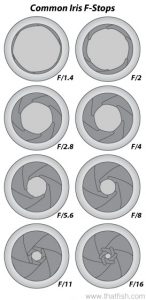Exposure is the art of capturing the appropriate amount of light required to produce a visually pleasing image. Proper exposure is critical to the final look of your film. By studying this exposure training you’ll be able to not only produce beautiful footage, but give yourself more freedom during post production to tailor the look of your film.
Spending a few extra minutes setting up your camera is well worth the effort. In fact, without proper exposure, you’re not likely to be pleased with your final product, and neither is your audience.
Light
Both photography and cinematography involve the process of capturing light. Light, be it from the sun, a lamp, stage lights, or a reflector, reflects, bounces, and scatters around a scene. Then, a few stray rays head toward the camera lens. Capturing the proper amount of light through that lens is what we are trying to accomplish.
The word photography means “writing (-graphy) with light (photo-)”. Cinematography is simply an extension of that same concept where we capture movement, or “cine”, through the use of many sequential photographs. Light is the key element of the process, and exposure is the way we capture the right amount of that light to get the image we desire.
Light is measured by two primary values: wavelength and intensity. Wavelength determines the color of light. Longer wavelengths are more red, while shorter wavelengths contain more blue. Exposure, however, is more concerned with the intensity of light, or the brightness level of the light entering the camera.
f-stops
![]() In photography exposure is measured in f-stops. This is a system that measures light in brightness based on the ratio of a lens’ focal length (f) and the diameter of the aperture size (D). Standard f-stops are f/1, f/1.4, f/2, f/2.8, f/4, f/5.6, f/8, f/11, f/16, f/22 with each number reducing the amount of light passing through the lens by one half.
In photography exposure is measured in f-stops. This is a system that measures light in brightness based on the ratio of a lens’ focal length (f) and the diameter of the aperture size (D). Standard f-stops are f/1, f/1.4, f/2, f/2.8, f/4, f/5.6, f/8, f/11, f/16, f/22 with each number reducing the amount of light passing through the lens by one half.
 Each step in the f-stop scale halves the amount of light allowed through the aperture. This is an exponential scale where each value is twice the previous. So, if you’re using an f/5.6 and then go to f/8, you’ve cut the light in half. If you then go to f/11, you’ve quartered the light from the f/5.6 value. Moving back up the scale doubles the light.
Each step in the f-stop scale halves the amount of light allowed through the aperture. This is an exponential scale where each value is twice the previous. So, if you’re using an f/5.6 and then go to f/8, you’ve cut the light in half. If you then go to f/11, you’ve quartered the light from the f/5.6 value. Moving back up the scale doubles the light.
Many lenses have the ability to adjust the aperture to thirds of a stop. This allows for better exposure control so you have a little latitude.
The amount of light that can be differentiated by a detector is called dynamic range. The human eye has roughly twenty stops of dynamic range. This means a variation of 220, or roughly one million times the difference between least sensitive and most sensitive. This is quite impressive. Unfortunately, film and image sensors are somewhat less sensitive.
Film stock varies quite a bit, but can achieve 13 or 14 stops, while DSLRs can only register about 8 stops.
Shutter Speed
While the aperture controls how much light makes it to the film or sensor, the shutter determines how long the film or image sensor is exposed to that light. Shutter speed is simply the length that the shutter is open (or, in the case of most video cameras, how long the image sensor absorbs light to be processed and recorded).
Shutter for Video
Because movies contain just that, moving pictures, we don’t mind if there’s a little motion blur on each frame. In fact, by reducing the shutter speed too far will eliminate so much of the motion blur that it begins to look like video and less like a movie shot on film.
A shutter speed of 1/40th should suffice for a film look. If you’re trying to create a shot that looks like video, ratchet it up to 1/60th or so to freeze the motion on each frame just enough to make it stutter.
ISO/Gain
ISO, or Gain is the sensitivity of the sensor in your camera. They’re measured differently, but do the exact same thing: to adjust how much your camera amplifies the signal your sensor sends to the recording system.
Most video cameras use Gain. This is measured in dB. DSLR cameras and many other digital film cameras use ISO, measured in hundreds, usually beginning with 100.